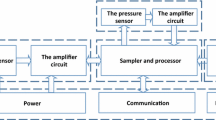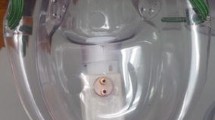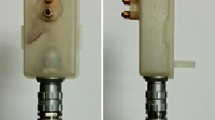Abstract
Measurement of gas flow and airway pressure at the Y-piece of an endotracheal tube provides valuable information about airway integrity and basic pulmonary function [1]. We describe the working principle and design of the D-lite sensor (Datex Division, Instrumentarium Corporation, Helsinki, Finland), which, in a single, lightweight adaptor piece, encloses flow, airway pressure, and sidestream gas measurement. The main emphasis in the design of this instrument was on reliable and accurate operation during continuous monitoring with exposure to humidity and mucus. Therefore, a robust flow-restrictor element with a pick-off arrangement resembling a Pitot tube was employed. This arrangement has nonlinear characteristics with potential difficulties in the measurement of small flows. However, these inherent drawbacks, together with compensations required because of varying gas fractions and pressure, can be handled by sophisticated computer algorithms at the host-monitor end (Capnomac Ultima [Datex Division, Instrumentarium Corporation, Helsinki, Finland]). Validation methods with main results and a brief review of applications are given.
Abstrakt
Die Messung des Gasstromes und des Atemwegdruckes am Y-Stück eines Endotracheal-Tubus gibt wertvolle Informationen zur Funktionder Atemwege und der Lungenfunktion (1). Wir beschreiben das Funktionsprinzipund den Aufbau des D-lite-Sensors (DATEX Division, Instrumentarium Corporation, Helsinki, Finnland), der in einem einzigen, leichtgewichtigenAnschlußstück die Messung von Gasstrom, Atemwegsdruck und Gasanalyse im Seitenstrom erlaubt. In der Entwurfsphase wurde besonders auf eineverläßliche und genaue Funktion bei kontinuierlichem Überwachungseinsatz unter der Einwirkung von Feuchtigkeit und Sekretbildung geachtet. Deshalb wurde eine robuste Gasstrom-Blende mit einer dem Pitot-Rohr entsprechenden Aufnahmen-Anordnung angewandt. Diese Anordnungweist eine nichtlineare Charakteristik auf, was bei kleinem Gasstrom zu Schwierigkeiten führen könnte. Dieser prinzipbedingte Nachteil wie auch notwendige Kompensationen für variierende Gasanteile und -drucke wird durch hochentwickelte Computeralgorithmen im Monitor gelöst (Capnomac Ultima (Data Division, Instrumentarium Corporation, Helsiniki, Finnland). Methoden zur Validierung und die wichtigsten Ergebnisse werden dargestellt sowie ein Überblick zu Anwendungen gegeben.
Resumen
La mediciòn del flujo de gas y de la presiòn de vìa aèrea entregan informaciòn valiosa en relaciòn a la integridad de la vìa aèrea y de la funciòn pulmonar. Describimos el principio de funcionamiento y el diseño del sensor D-lite (Datex Division, Instrumentarium Corporation, Helsinki, Finland), el cual, en una pieza adaptadora ùnica y liviana, incorpora mediciones de flujo, presiòn de vìa aèrea, y mediciòn de gases lateral al flujo. El mayor ènfasis en el diseño de este instrumento fue su operaciòn exacta y confiable durante monitorizaciòn continuada con exposiciòn a humedad y mucosidades. Por lo tanto, se utilizò un elemento restrictor de flujo robusto, en una disposición de muestreo (“pick-off”) similar al tubo de Pitot. Esta disposiciòn posee caracterìsticas no-lineales con dificultades potenciales en la mediciòn de flujos pequeños. Sin embargo, estas desventajas inherentes, junto con las compensaciones requeridas debido a las fracciones de gas y presiones cambiantes, pudieron ser manejadas mediante algoritmos computacionales sofisticados a nivel del monitor-huèsped (Capnomac Ultima [Data Division, Instrumentarium Corporation, Helsinki, Finland]). Se presentan los mètodos de validaciòn con los resultados principales y una breve revisiòn de las aplicaciones.
Similar content being viewed by others
References
Feldman JM. Respiratory monitoring—a perspective. Sem Anesth 1992;11:150–157
Sullivan WJ, Peters GM, Enright PL. Pneumotachographs: Theory and clinical application. Respir Care 1984;29:736–749
Yoshia I, Shimada Y, Tanaka K. Evaluation of a hot-wire respiratory flow-meter for clinical applicability. J Appl Physiol 1979;47:1131–1135
Cox LA, Almeida AP, Robinson JS, Horsley JK. An electronic respirometer. Br J Anaesth 1974;46:302–310
Plaut DI, Webster JG. Ultrasonic measurement of respiratory flow. IEEE Trans Biomed Eng 1980;BME-27:549–558
Buess C, Pietsch P, Guggenbuehl W, Koller EA. Design and construction of an ultrasonic air-flowmeter. IEEE Trans Biomed Eng 1986;BME-33:768–774
White DF, Rodely AE, McMurtrie CL. The vortex shedding flowmeter. Flow: Its measurement. Control Sci Ind 1974;1:967–974
Elliot SE, Shore JH, Barnes CW, et al. Turbulent airflow meter for long-term monitoring in patient-ventilator circuits. J Appl Physiol 1977;42:456–460
Wolf AR, Volgyesi GA. A modified Pitot tube for accurate measurement of tidal volume in children. Anesthesiology 1987;67:775–778
Validation of Capnomac Ultima™ tidal volume measurement. Helsinki: Datex, 1992:Document #881453
Milic-Emili J, Robatto FM, Bates JHT. Respiratory mechanics in anaesthesia. Brit J Anaesth 1990;65:4–12
Bardoczky GI, d'Hollander A. Continuous monitoring of the flow-volume loops and compliance during anesthesia. J Clin Monit 1992;8:251–252
Huffman LM. Monitoring ventilation and compliance with Sidestream Spirometry™. AANA Journal 1991;59:249–258
Huffman LM. Monitoring compliance: A sensitive indicator of chance. AANA Journal 1992;60:217–220
Sidestream Spirometry™: Monitoring patient ventilation during anesthesia: Appliguide. Helsinki: Datex, 1992: Document #881418
de Wries JW, Haanschoten MC. Capnography does not reliably detect double-lumen endotracheal tube malplacement. J Clin Monit 1992;8:236–237
Simon BA, Hurford WE, Alfille PH, et al. An aid in the diagnosis of malpositioned double-lumen tubes. Anesthesiology 1992;76:862
Doebelin EO. Measurement systems, application and design. Tokyo: McGraw-Hill, 1976:465–469
Author information
Authors and Affiliations
Rights and permissions
About this article
Cite this article
Meriläinen, P., Hänninen, H. & Tuomaala, L. A novel sensor for routine continuous spirometry of intubated patients. J Clin Monitor Comput 9, 374–380 (1993). https://doi.org/10.1007/BF01618680
Received:
Revised:
Accepted:
Issue Date:
DOI: https://doi.org/10.1007/BF01618680




